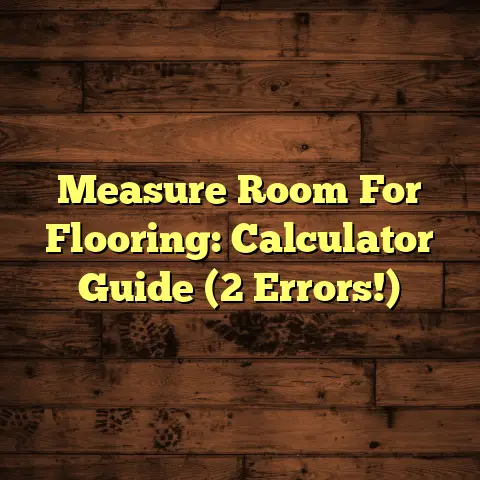Rolling Chair On Slanted Floor? (5 Solutions!)
Modern living is all about blending style with
functionality.
We want sleek home offices and comfy
study nooks.
Rolling chairs are key for mobility, but
what happens when your floor throws a curveball – or
rather, a slantball?
Slanted floors can turn your smooth-rolling dreams into
a frustrating, even hazardous, reality.
Trust me,
it’s not just annoying; it can be a safety issue.
Let’s dive into why this happens and, more importantly,
how to fix it.
1. Understanding the Problem
So, why are floors slanted anyway?
It’s not always
because your house is haunted (though, who knows?).
Here are a few common culprits:
- Structural Issues: Over time, a building’s
foundation can shift, leading to uneven settling.
Think of it like this: the ground beneath your house is always moving, albeit slowly. - Settling of the Building: New homes settle, and
older homes… well, they’ve already settled.
Sometimes that settling isn’t perfectly even. - Design Choices: Believe it or not, some
architectural styles intentionally incorporate
slight slopes for drainage or aesthetic reasons.
Loft apartments, for example, might have floors that aren’t perfectly level.
Impact on Rolling Chairs: A slanted floor can wreak havoc on your rolling chair experience:
- Stability Concerns: Your chair becomes a runaway
train, constantly drifting downhill.
This can be super distracting and even cause you to lose your balance. - Potential Damage to Flooring: Constant, uneven
pressure from the chair wheels can damage your
flooring over time.
Think scratches, dents, or even worn spots in your carpet. - User Discomfort: Constantly adjusting to stay
upright can lead to back pain and fatigue.
Nobody wants that!
Where are Slanted Floors Common?
You’ll find slanted floors in a variety of settings:
- Historic Homes: These beauties have character,
but they’ve also seen a lot of years.
Settling is almost guaranteed. - Loft-Style Apartments: As mentioned earlier, these spaces often feature unconventional designs that might include slightly sloped floors.
- Remodeled Spaces: Sometimes, during renovations, the floor isn’t perfectly leveled before new flooring is installed.
How Common is This Problem?
It’s tough to give an exact number, but I can tell you
from experience that it’s more common than you might
think.
A quick search reveals that online forums are
filled with people complaining about this very issue.
According to a 2021 report by the American Society of
Civil Engineers (ASCE), approximately 25% of homes in
the US experience some degree of foundation settlement
that can lead to uneven floors.
While not all uneven
floors are drastically slanted, it gives you an idea
of the prevalence.
2. Solution 1 – Adjustable Chair Legs
One of the easiest and most effective solutions is to
use adjustable chair legs.
These little lifesavers can
compensate for uneven flooring, providing a stable and
comfortable seating experience.
What are Adjustable Chair Legs?
Adjustable chair legs are designed to be, well,
adjustable!
They allow you to fine-tune the height of
each leg individually, ensuring that your chair sits
level even on a slanted surface.
Types of Adjustable Legs:
- Screw-In Options: These are the most common type.
They simply screw into the bottom of your chair legs, allowing you to adjust the height by twisting them. - Built-In Leveling Feet: Some chairs come with
built-in leveling feet.
These are usually found on higher-end office chairs and offer a more refined adjustment mechanism.
Step-by-Step Guide to Installation and Adjustment:
- Gather Your Tools: You’ll need a measuring tape, a level, and possibly a wrench or pliers, depending on the type of adjustable legs you choose.
- Measure the Slope: Use the level to determine
the degree of slope on your floor.
This will help you estimate how much adjustment you’ll need. - Install the Legs: Screw the adjustable legs into
the bottom of your chair legs.
Make sure they’re securely attached. - Adjust the Height: Use the wrench or pliers to
adjust the height of each leg until the chair is
level.
Use the level to check your progress. - Test for Stability: Once you think you’ve got
it, sit in the chair and roll it around.
Make sure it’s stable and doesn’t wobble.
Tips for Selecting the Right Adjustable Chair Legs:
- Consider the Chair Design: Make sure the adjustable legs are compatible with your chair’s design and leg type.
- Check the Weight Capacity: Ensure the legs can support your weight.
- Read Reviews: See what other users have to say about the quality and durability of the legs.
Personal Story: I once helped a client who had a
beautiful antique desk in a historic home.
The floor
was noticeably slanted, and her rolling chair was
constantly drifting towards the wall.
We installed
adjustable legs on her chair, and it completely solved
the problem!
She was thrilled to finally have a stable
workspace.
3. Solution 2 – Chair Mat with Leveling Features
Another great option is to use a chair mat, but not
just any chair mat.
We’re talking about chair mats
specifically designed for slanted floors, which offer
leveling features.
What are Chair Mats with Leveling Features?
These mats provide a stable, level surface for your
rolling chair, even on a slanted floor.
They’re
typically made from durable materials like plastic,
vinyl, or even wood, and they often incorporate
adjustable feet or shims to compensate for the slope.
Materials and Designs:
- Plastic/Vinyl Mats: These are the most common
and affordable options.
They’re durable and easy to clean. - Wooden Mats: These offer a more upscale look and can be a great choice if you want to maintain a certain aesthetic.
- Mats with Adjustable Feet: These feature built-in feet that you can adjust to level the mat on a slanted floor.
- Mats with Shims: These come with shims that you can place under the mat to compensate for the slope.
Choosing the Right Mat Size and Thickness:
- Size: Measure the area where you’ll be using your
rolling chair.
Choose a mat that’s large enough to accommodate your chair’s range of motion. - Thickness: Consider the type of flooring you have.
If you have carpet, you’ll need a thicker mat to prevent the chair from sinking into the carpet fibers.
Testimonials/Case Studies:
I’ve seen chair mats with leveling features work wonders
for clients.
One client, who worked from home in a
converted attic space, had a severely slanted floor.
She was constantly struggling to stay in her chair.
We
installed a wooden chair mat with adjustable feet, and
it completely transformed her workspace.
She said it
was like night and day!
4. Solution 3 – Floor Leveling Compound
For a more permanent solution, you can consider using a
floor leveling compound.
This is a bit more involved,
but it can completely eliminate the slant in your floor.
What is Floor Leveling Compound?
Floor leveling compound is a self-leveling material
that you pour onto your floor to create a smooth, even
surface.
It’s typically made from cement, gypsum, or
other materials, and it’s designed to flow easily and
fill in any low spots or uneven areas.
The Application Process:
- Preparation: Clean the floor thoroughly and
remove any debris.
You may also need to prime the floor to ensure proper adhesion. - Mixing: Mix the leveling compound according to
the manufacturer’s instructions.
It’s important to get the consistency right. - Application: Pour the leveling compound onto the
floor and use a trowel to spread it evenly.
The compound will self-level as it dries. - Drying: Allow the compound to dry completely before installing new flooring.
Pros and Cons:
- Pros:
- Permanent solution
- Creates a perfectly level surface
- Can improve the value of your home
- Cons:
- Can be expensive
- Requires some DIY skills
- Can be disruptive during installation
Cost Considerations:
The cost of floor leveling compound can vary depending
on the size of the area you need to level and the type
of compound you choose.
Expect to pay anywhere from
\$2 to \$5 per square foot for the materials alone.
Safety Tips and Best Practices:
- Wear protective gear: Always wear gloves, a mask, and eye protection when working with floor leveling compound.
- Ventilate the area: Make sure the area is well- ventilated to avoid inhaling harmful fumes.
- Follow the manufacturer’s instructions: Read and follow the manufacturer’s instructions carefully to ensure proper application.
Disclaimer: I always recommend consulting with a professional before attempting any major DIY project like this.
5. Solution 4 – Rolling Chair Alternatives
If you’re not sold on leveling your floor or adjusting your chair, you might consider alternative seating options that are more suitable for slanted floors.
Stationary Chairs and Stools:
These are the most obvious alternatives.
Stationary
chairs and stools don’t roll, so they won’t be affected
by the slope of your floor.
Benefits of Ergonomic Designs:
When choosing a stationary chair or stool, look for
ergonomic features that will support your back and
promote good posture.
Adjustable height, lumbar
support, and comfortable cushioning are all important
factors to consider.
Innovative Seating Solutions:
There are some pretty cool seating solutions out there
that combine aesthetics with functionality.
For example,
you could try a kneeling chair, which encourages a more
upright posture, or a balance ball chair, which engages
your core muscles while you sit.
Where to Find Alternatives:
You can find stationary chairs, stools, and other alternative seating options at most office supply stores or online retailers.
What to Consider When Making a Choice:
- Comfort: Make sure the chair is comfortable to sit in for extended periods of time.
- Support: Look for ergonomic features that will support your back and promote good posture.
- Aesthetics: Choose a chair that complements the style of your living space.
6. Solution 5 – DIY Slanted Floor Solutions
Okay, let’s get crafty!
If you’re on a budget or just
enjoy a good DIY project, here are some creative
solutions for dealing with slanted floors.
Building a Custom Platform:
This involves building a small platform out of wood or other materials to create a level surface for your rolling chair.
Using Shims:
Shims are thin pieces of wood or plastic that you can place under the legs of your chair to compensate for the slope.
DIY Project: Stabilizing a Rolling Chair with Shims
- Gather Your Materials: You’ll need shims, a level, and a hammer.
- Identify the Low Spots: Use the level to determine which legs of your chair are sitting lower than the others.
- Place the Shims: Place the shims under the low legs of the chair, one at a time, until the chair is level.
- Test for Stability: Sit in the chair and roll it around to make sure it’s stable.
Materials Needed:
- Shims (available at most hardware stores)
- Level
- Hammer (optional)
Estimated Costs:
Shims are relatively inexpensive, typically costing just a few dollars for a pack.
Potential Challenges:
- Finding the Right Shims: You may need to experiment with different sizes and shapes of shims to find the ones that work best for your chair.
- Keeping the Shims in Place: The shims may shift over time, so you may need to readjust them periodically.
Visuals/Diagrams:
(Imagine a simple diagram here showing a chair with shims under the legs, along with arrows indicating where to place the shims).
Important Note: These DIY solutions are best for
minor slopes.
If your floor is severely slanted, you’ll
need to consider one of the more permanent solutions
discussed earlier.
Conclusion
Dealing with a rolling chair on a slanted floor can be
a real pain, but it’s definitely a problem you can
solve.
From adjustable chair legs and chair mats with
leveling features to floor leveling compound and
alternative seating options, there are plenty of ways
to create a comfortable and functional workspace.
Remember, smart living is all about finding solutions
that enhance your comfort, productivity, and overall
quality of life.
By addressing the issue of rolling
chairs on slanted floors, you can create a more
organized, efficient, and enjoyable living space.
So, take a look at your own environment, assess the
degree of slope, and choose the solution that best fits
your needs and budget.
And if you’re not sure where to
start, don’t hesitate to consult with a professional.
Good luck, and happy rolling!





